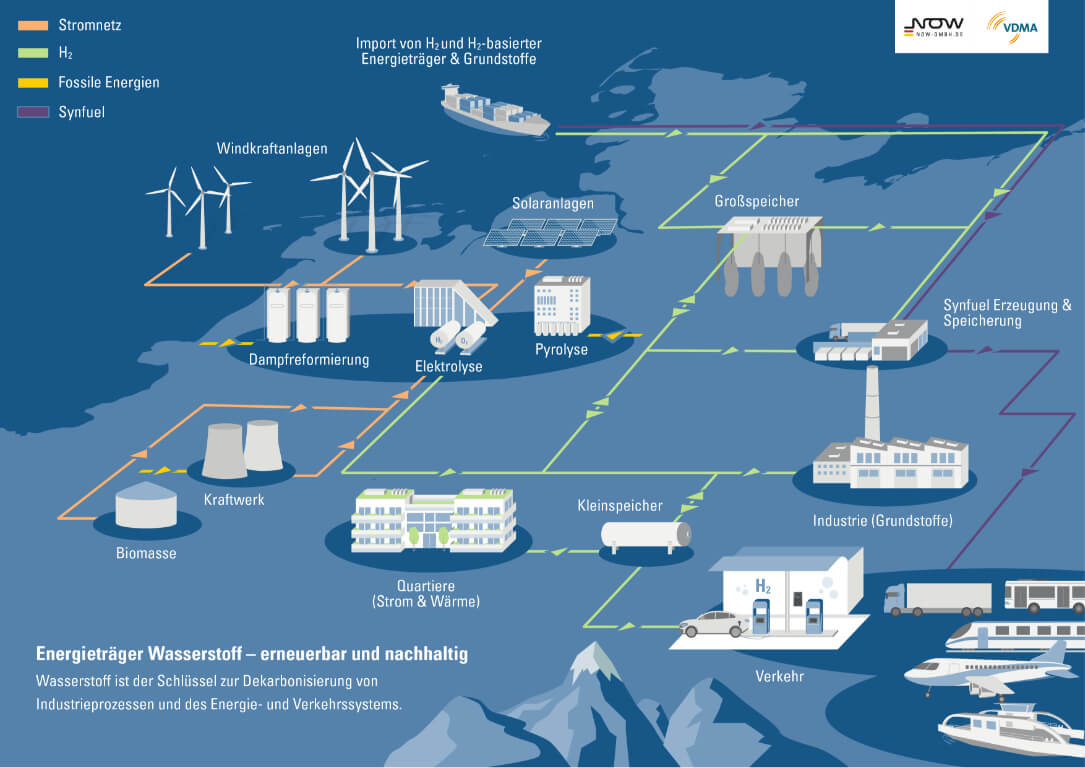HyLand – Hydrogen Regions in Germany
“HyLand – Hydrogen Regions in Germany” is a competition launched in 2019 by the Federal Ministry of Digital and Transport (BMDV – Bundesministerium für Digitales und Verkehr), which is already in its second round. HyLand motivates participants in all regions of Germany to initiate, plan and implement hydrogen-related concepts. The aim of the competition is to identify and promote the most innovative and promising regional concepts.
HyStarter, HyExperts and HyPerformers – Discovering and implementing the potential of hydrogen
In the first round of HyLand (HyLand I), concepts in three categories with different objectives and funding priorities were selected from over 200 concept submissions from all over Germany.
Within the scope of HyLand II, 30 further municipalities and regions were awarded the status of HyStarter or HyExperts in September 2021. As part of the HyLand network, the regions are supported and accompanied with the corresponding funding instruments and networks in the creation of regionally integrated concepts for the introduction of hydrogen and fuel cell technology in transport.
All further information on the winners of HyLand II can be found here.
The HyLand map will take you directly to the respective HyLand projects and regions. Here you will find information and materials on partners, goals and contents of the HyLand projects. Get an idea of the diverse applications of hydrogen technologies in practice.
The HyLand projects at a glance:
HyStarter
HyLand I: 9 regions, HyLand II: 15 regions – Activation, organisation of the stakeholder landscape
HyExperts
HyLand I: 13 regions, HyLand II: 15 regions – Development of concepts ready for implementation
HyPerformer
Hyland I: 3 regions, Hyland II: 3 regions – Development and implementation of concrete hydrogen projects
Germany is becoming a hydrogen nation! The HyLand initiative is an important milestone on Germany’s path to becoming one of the world’s leading hydrogen states. The HyLand funding scheme reaches out into rural areas and helps to build up a local hydrogen economy. The aim is for the hydrogen to be produced locally from renewable energies wherever possible and subsequently also utilised in the region. HyLand is a new and holistic approach to mobility, from the production of energy to propulsion technology and refuelling infrastructure. In its capacity as a federal company, NOW GmbH is coordinating the competition.

Hydrogen – A key technology for achieving the climate targets
The German government’s climate protection plan envisages a reduction of 55% of carbonemissions in Germany by 2030 compared to 1990. Green, in other words sustainably produced hydrogen and its applications are key technologies for achieving the national climate targets. The multiple uses of hydrogen as energy storage and fuel enable sector coupling. In this way, energy production and mobility constitute the basis for the development of a sustainable energy system in Germany.
Mobility connects people, the economy and infrastructures, on land, at sea and in the air. However, the mobility sector is the third largest emitter of carbon emissions in Germany. Today, the diverse mobility sectors are undergoing rapid and profound structural change and are at the heart of shaping a sustainable economy and society. In addition to new multimodal mobility concepts that focus on the resource-saving digital networking of mobility offers in individual, local and long-distance transport, the other key pillar in the development of low-emission and environmentally friendly mobility of the future lies in sustainable mobility technologies based on electricity, energy efficiency and the use of new energy sources. Hydrogen plays a central role here, enabling and facilitating this change.
The HyLand partners and their projects are driving hydrogen into planning and concrete practical applications in all regions of Germany, thereby already demonstrating the importance and potential of hydrogen as a future technology in mobility as well as in other sectors.
National Innovation Programme Hydrogen and Fuel Cell Technology
“HyLand – Hydrogen Regions in Germany” is part of the National Innovation Programme Hydrogen and Fuel Cell Technology (NIP 2). With NIP 2, the Federal Ministry of Digital and Transport (BMDV – Bundesministerium für Digitales und Verkehr) is shaping and supporting the market launch of applications in this field. Funding is being provided for research and development projects, but also for procurement measures. In addition to contributing to climate protection, an important aim is to maintain and expand the technological leadership of German industry and the associated creation and safeguarding of sustainable jobs.
The NIP also supports the development, refinement and implementation of integrated hydrogen concepts that address the regional production of – preferably green – hydrogen, its supply and demand through concrete local applications, especially in the transport sector. By bundling funding in certain pioneer and lighthouse regions and penetrating the regional economy, mobility and energy supply, the real use of the technology can be demonstrated on a broad scale while at the same time having an external impact, allowing synergies to be exploited and investment sums to be mitigated.


